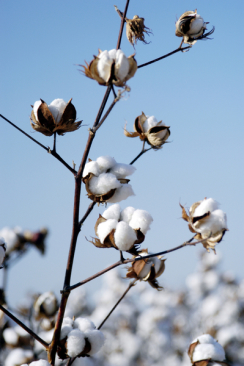
Why Organic Cotton?
Updated
I used to pride myself in choosing to wear cotton clothing. I was about to start discussion with a factory in Asia about producing child-size handkerchiefs when my research informed me that conventional cotton cultivation is not very eco-friendly at all. That was how I ended up importing organic cotton handkerchiefs for sale in the UK and EU, back in 2004.
The basics on organic cotton agriculture here:
There are many issues about conventional cotton cultivation, relating to its requirements of water, pesticides, artificial fertilisers, etc. Then there is the human factor related to forced labour, child labour, etc.
There have been several "success stories" since organic●ally started. For example, Uzbekistan used to force children into picking cotton. There was a concerted effort to stop this. There was a boycott of cotton from Uzbekistan. Recently I met a staff member of ILO who reported on how the joined-up efforts of the government, international organizations and businesses have led to children being freed from this labour.
Relevant links:
Consolidating Reforms to End Forced Labor and Promoting Responsible Sourcing From Uzbekistan
Uzbek cotton is free from systemic child labour and forced labour
The Uzbek case shows how consumers and governments and civil society TOGETHER can make a difference.
However, while the child labour issue appears to be resolved (at least for now), there are still other "people issues" related to power and inequality.
"Beginning in 2019, the swift privatization of Uzbekistan’s cotton sector has facilitated a grand scale transfer of hundreds of thousands of hectares of farmers’ land to private operators (known as cotton “clusters”). Many of these transfers have been carried out illegally by local officials, without farmers’ consent, redress or compensation.
The clusters are private, vertically integrated enterprises that combine the production of raw cotton, processing and manufacture of yarn or textiles. Farms that are not being operated directly by clusters (direct farming) are now under contract to grow cotton for them (contract farming). In general, only one cluster operates in each district of Uzbekistan’s 13 regions, which has created a monopoly situation in which farmers have no choice over whom they can produce cotton for, leaving them vulnerable to exploitative practices.
Uzbek Forum’s monitoring findings of the 2020 and 2021 cotton harvests confirmed that abusive clusters impose below-market prices for cotton, unrealistic production targets, inflated costs for inputs such as fuel and fertilizers and fail to pay for delivered cotton, leaving many farmers in crippling debt. Farmers told Uzbek Forum during the 2021 harvest they still had not received payment for cotton they delivered in 2020."
Source: www.cottoncampaign.org
See also: Illegal Land Confiscations in Uzbekistan: Farmers in NAMANGAN fight for their rights and livelihoods
Despite all this, only about "0.1% of the country’s overall cotton production was estimated to be certified organic" (See Textile Exchange 2022 Report, page 48). There is still much to do around the world to get people to steer away from pesticide-laden agriculture, whether for clothes or for food.
2022: 60 years since the publication of Rachel Carson's Silent Spring. What happens when we kill off all the insects with our pesticides? Learn more about pesticides here.
Why organic cotton?
- According to The Soil Association, conventional cotton alone is responsible for 16% of all insecticides sold worldwide. When organic●ally™ first started, non-organic cotton, though occupying only 3% of the world’s farmland, was using 25% of the world’s chemical pesticides which ends up not only in the cotton, but in the air, water and soil. The drop in insecticide use from 25% to 16% suggests that our efforts are reaping results.
- The most acutely toxic pesticide registered by the Environment Protection Agency is aldicarb. In California alone between 1970 and 1994, 85 to 95% of total aldicarb was used on cotton.
- Organic cotton farmers eliminate the use of toxic chemicals in every step of the growing process by emphasizing natural and biological methods which do not harm the environment.
- "A young boy of eight had been helping his parents by weeding in the cotton fields. Feeling thirsty, he ran back to the house, but found an empty container by the path and used it to scoop up some water from a ditch. He did not return home, and a village search found his body next to the empty endosulfan bottle innocently used to quench his thirst."
Read how organic cotton (and other) farming is actually helping farmers:

